This easy sourdough focaccia recipe combines delicious and soft sourdough with olive oil, flaky sea salt, and savory herbs. With its crispy crust and robust flavor, this Italian rustic bread will become a regular recipe gracing your table.
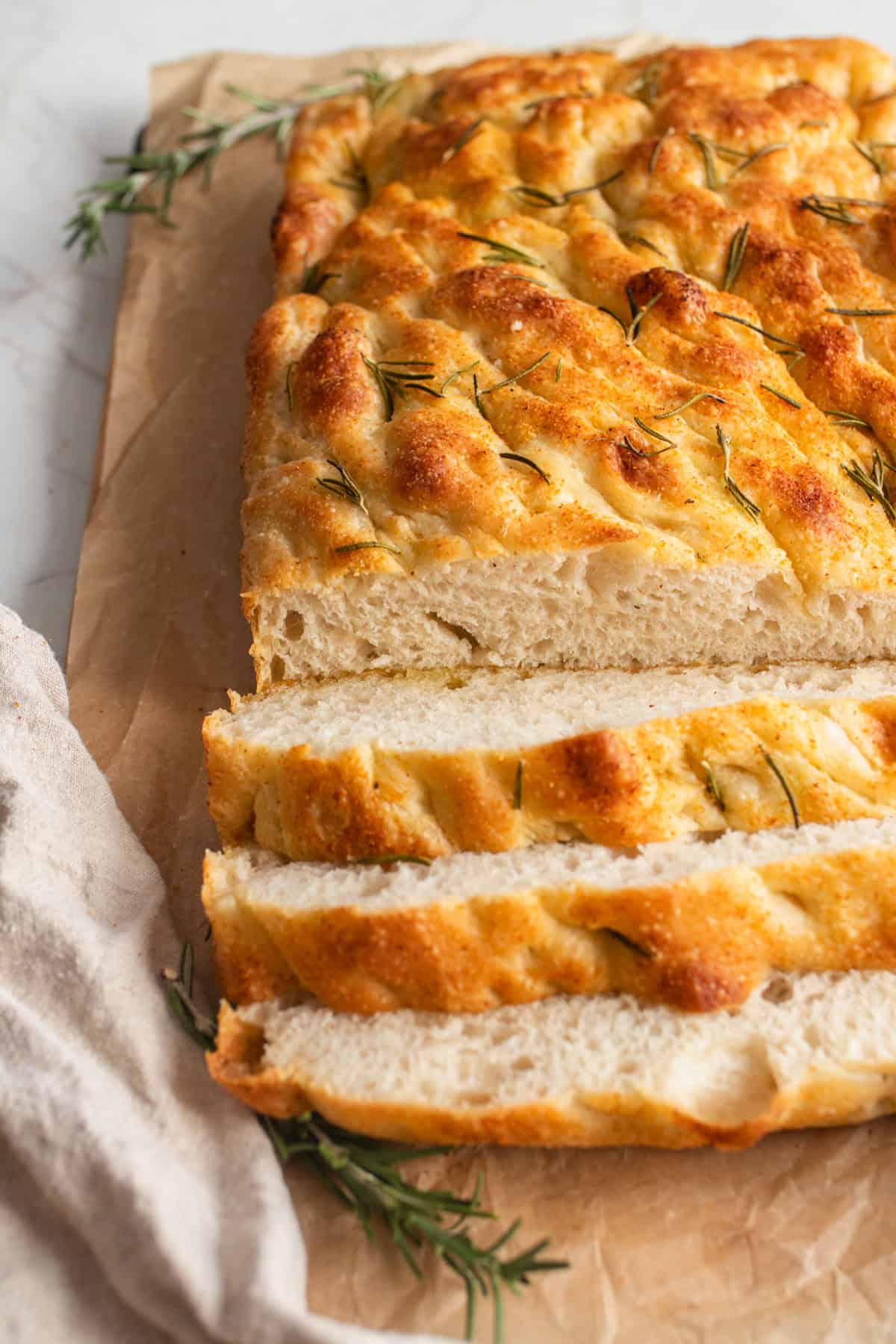
Sourdough can be one of those things that people really overcomplicate. Especially if you are new on your sourdough journey, baking can be intimidating. But it doesn’t have to be that way! Like my beginner’s sourdough loaf or sourdough cinnamon rolls, this sourdough focaccia bread recipe is a great recipe for beginners. This easy recipe will quickly become a staple for you too.
Focaccia is a classic Italian bread that is deliciously flavored with olive oil and salt. Add in some fresh rosemary on top for an earthy flavor that perfectly compliments the richness of the olive oil. Your tastebuds will love it.
It can be used as a side dish, paired with things like Pumpkin Chili or Roasted Red Pepper And Tomato Soup. It’s also great for lunch sandwiches or even a sourdough breakfast sandwich. I like to use it as the base for my avocado toast with a perfect sunny side up egg on top.
Why You’ll Love this Recipe
Delicious and easy – This is a soft, salty, olive oil flavored sourdough bread with a hint of fresh rosemary. It’s super delicious with an amazing flavor profile and simple, easy to use ingredients.
Versatile – Bake it plain or adds herbs, cherry tomatoes, or mozzarella cheese. I even use this to make flatbread pizzas instead of my usual sourdough pizza dough. There are so many great options when it comes to sourdough focaccia dough.
Feeds a crowd – This recipe is great for a party appetizer or as part of a charcuterie board. Even if you are making it for a few people, it’s great to have leftover for sandwiches or a special afternoon treat.
Ingredients
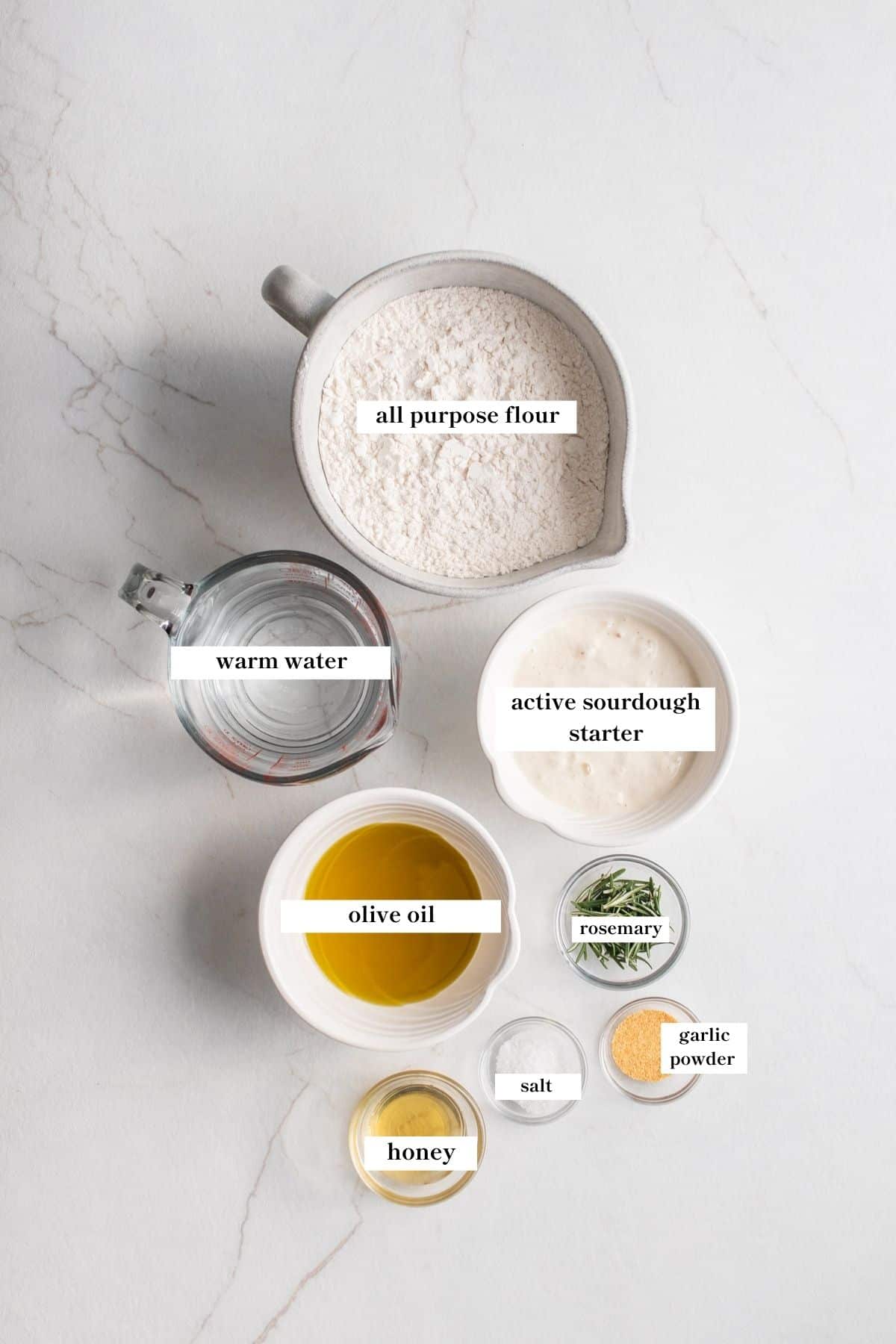
- Sourdough starter – Active starter (not discard) is used for this recipe. If you want to try a discard version, check out my sourdough discard focaccia recipe here. New to sourdough? Learn how to make a sourdough starter here.
- Extra virgin olive oil – This is the traditional oil used for focaccia, but you can use other oil if that is what you have on hand. I like to use a high quality olive oil for this since it will really impact the flavor of your bread.
- All-purpose flour – If you are exploring the world of freshly milled grains like me, you could do half whole wheat flour and half all purpose. I always suggest trying that before going all whole wheat.
A full ingredient list with exact amounts can be found in the recipe card below.
Tools You May Need
Stand mixer with a dough hook attachment
9 x 13 Baking Dish – I prefer to bake this in something that is about 3 inches in depth.
Sourdough Focaccia Variations
There is no limit to what you could add to this simple bread!
- Sun-Dried Tomato and Olive Focaccia – Incorporate chopped sun-dried tomatoes, Kalamata olives, oregano, and thyme into the dough. Drizzle with olive oil, sprinkle with sea salt, and bake. Serve with fresh basil.
- Caramelized Onion and Gruyère Focaccia – Fold sautéed caramelized onions and grated Gruyère cheese into the dough. Drizzle with olive oil and bake until crispy and golden. Garnish with fresh thyme.
- Fig and Prosciutto Focaccia – Mix dough with chopped dried figs and a touch of honey. After baking, top with prosciutto slices, drizzle with olive oil, and garnish with fresh arugula and sea salt.
How to Make Sourdough Focaccia
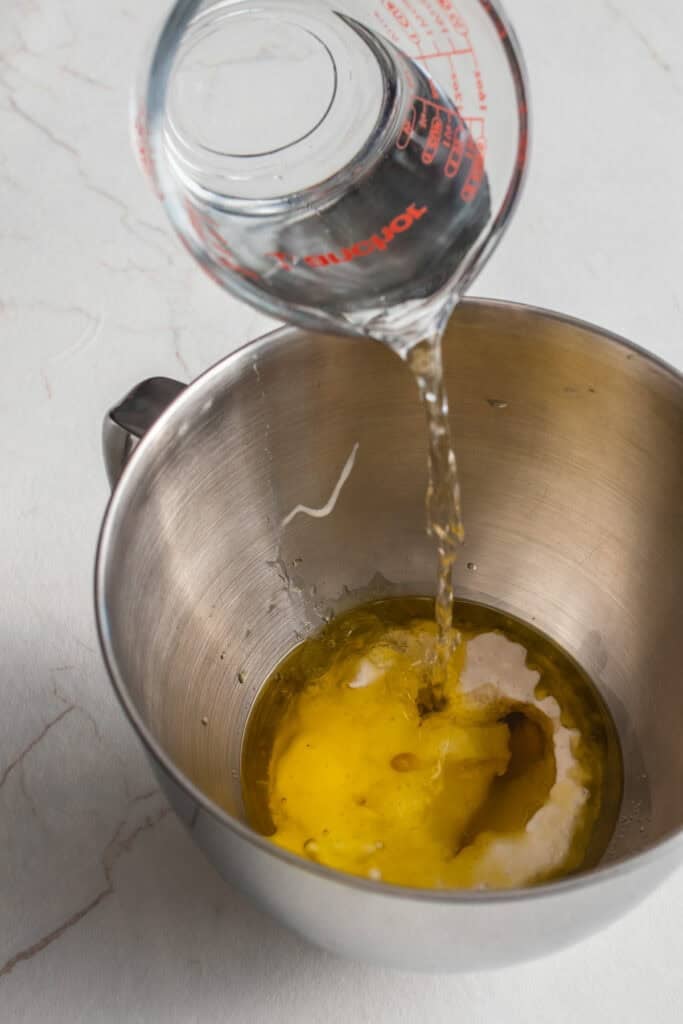
Step 1: Combine the sourdough starter, water, 1/4 cup olive oil, honey, and salt in the bowl of a stand mixer with a dough hook.
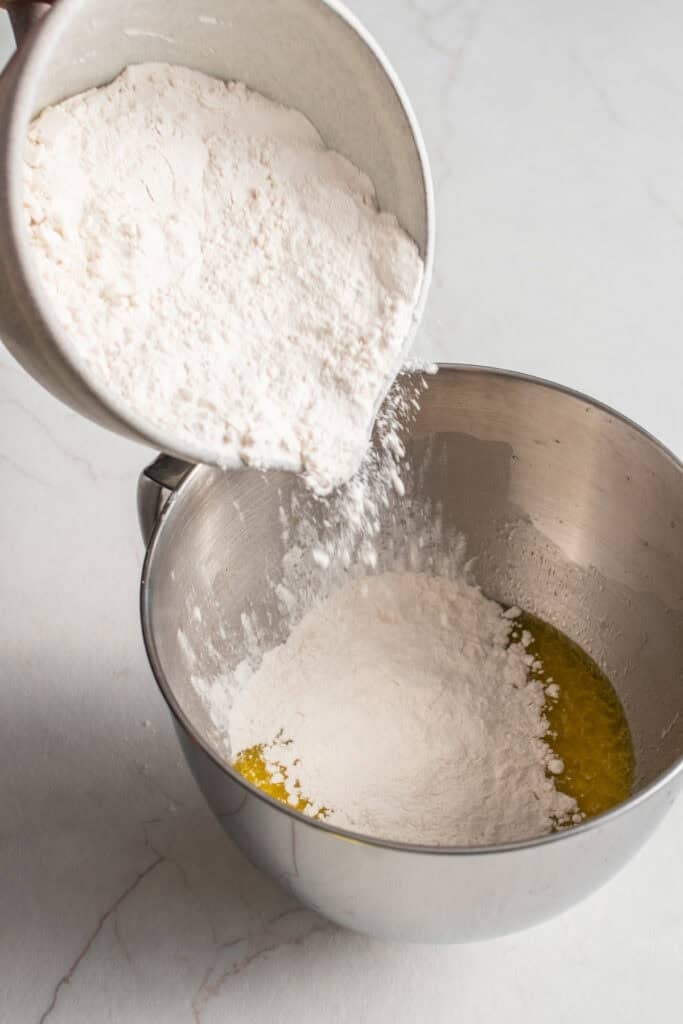
Step 2: Add the flour a half cup at a time until it starts pulling away from the sides of the bowl.
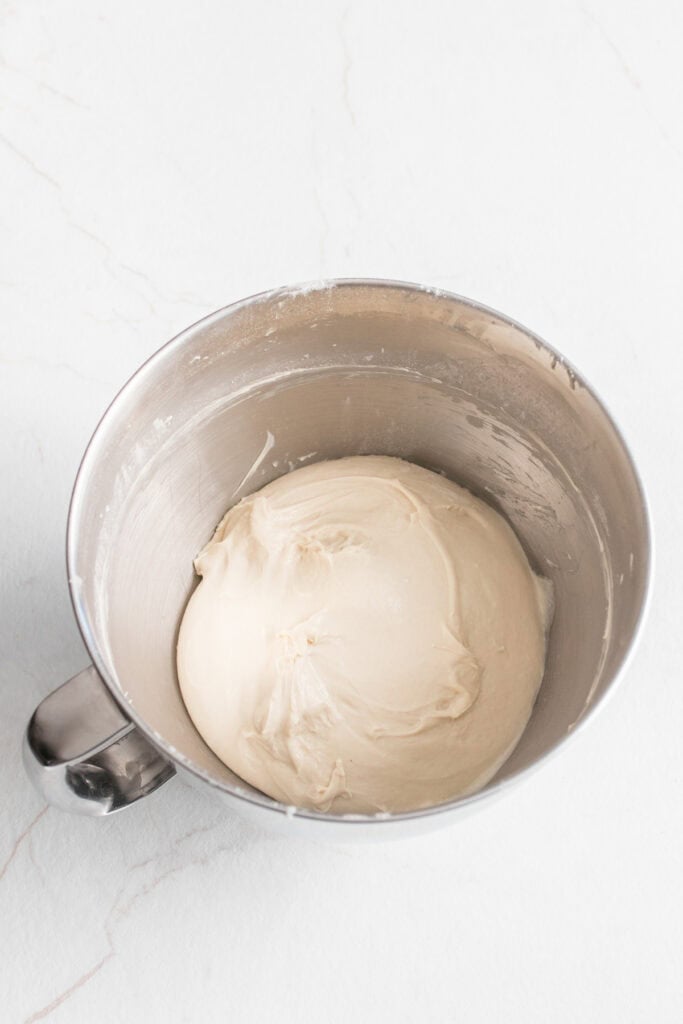
Step 3: With your mixer on low to medium speed, knead until smooth and elastic. This could take anywhere from 10 to 40 minutes.
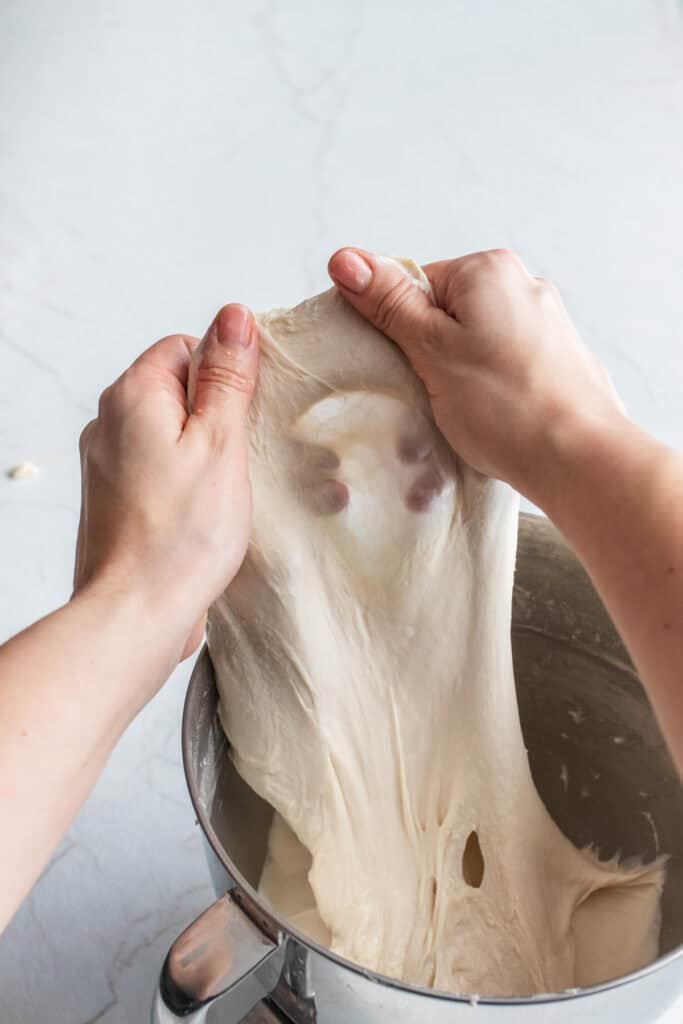
Step 4: It should pass the windowpane test. Grab a small piece of dough and stretch it into a square. If it can stretch thin enough to see through without breaking, the dough is ready.
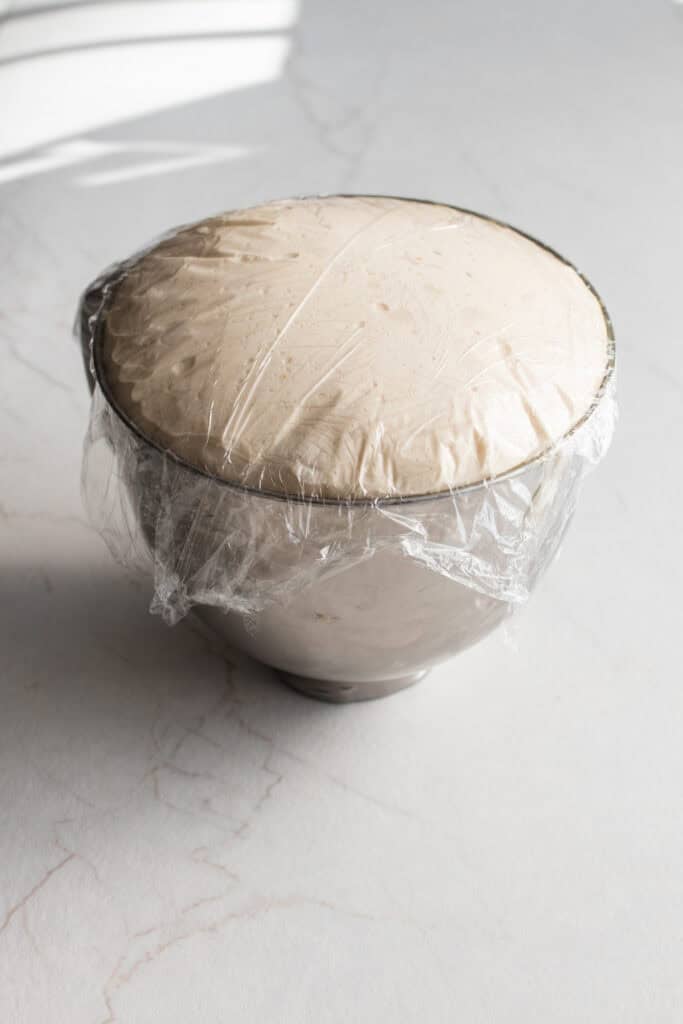
Step 5: Place dough in a greased bowl and cover with plastic wrap or a tea towel. Let it ferment at room temperature until it is bubbly/puffy and has increased by about half the volume. The time this takes can vary on many factors, especially temperature and time of year. This could take 4 hours if left in a warm place. I sometimes let it go 8 to 12 hours. Be careful not to over ferment the dough.
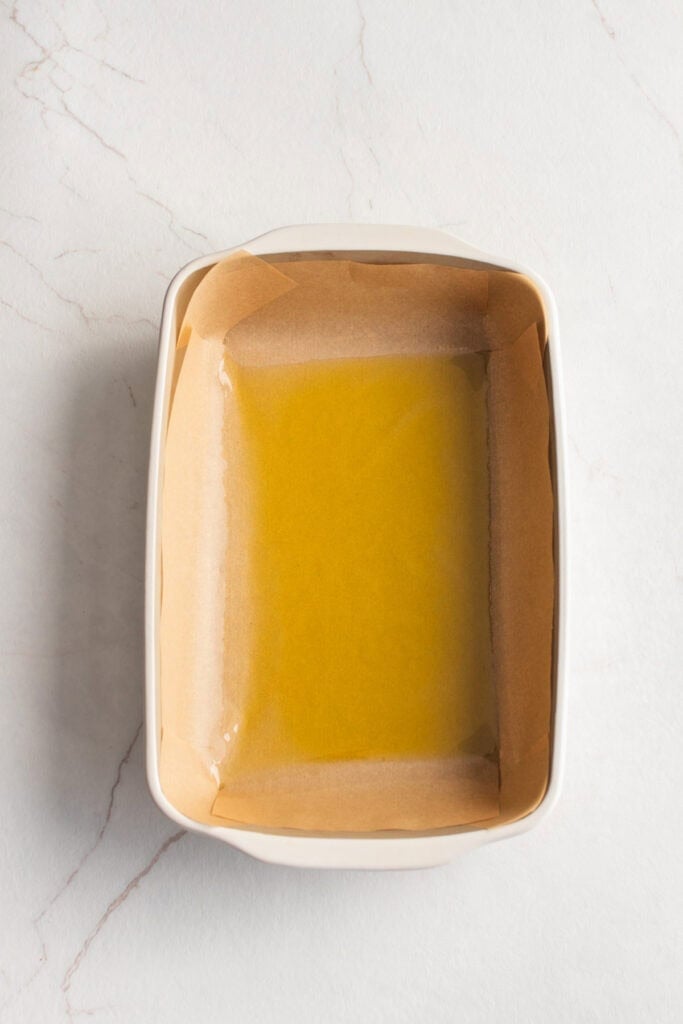
Step 6: Put 1/4 cup olive oil in the bottom of a 9 by 13 baking dish lined with parchment paper.
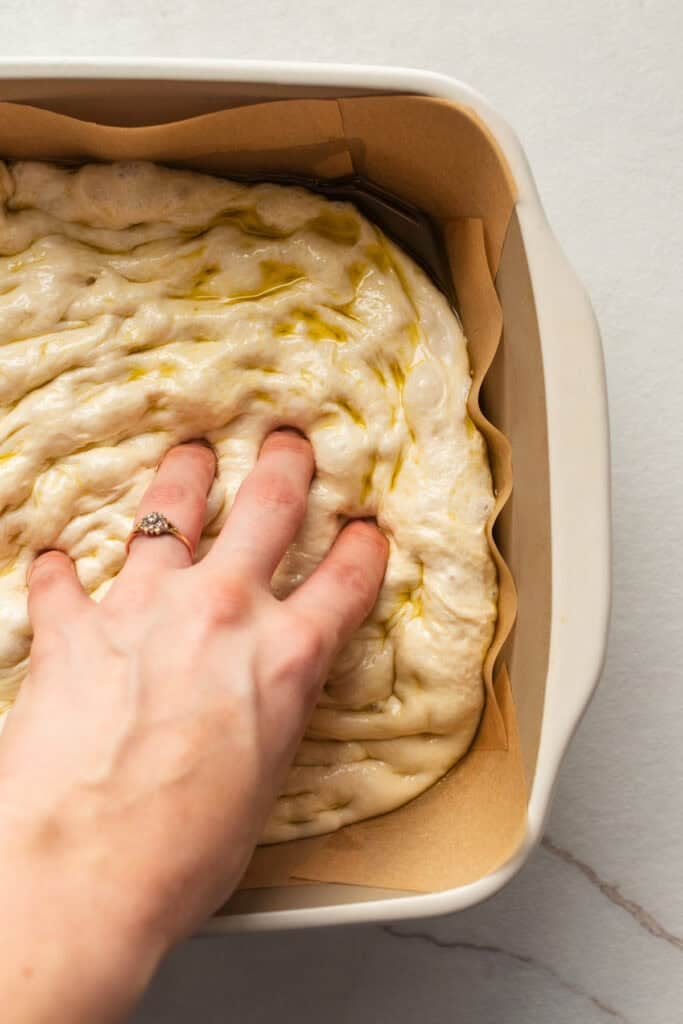
Step 7: Press dough out in the baking dish, pressing fingers down in the dough carefully. Be careful not to deflate it, and press it all the way to the edges.
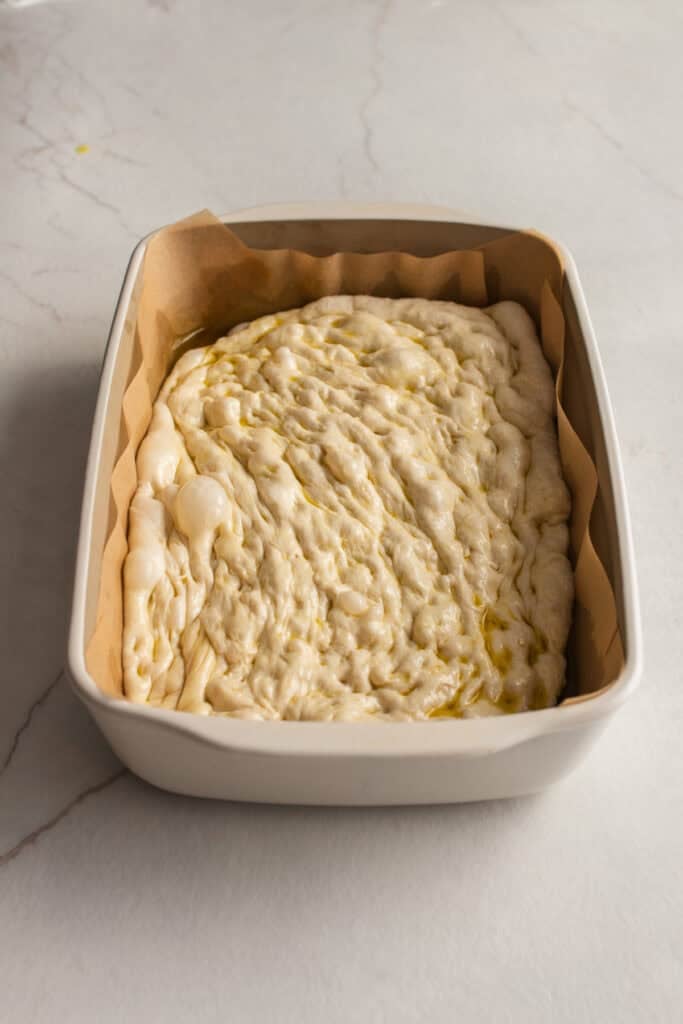
Step 8: Cover the dough in the baking dish with a tea towel or plastic wrap and allow it to rise for 1 to 2 hours at room temperature. It won’t double in size, but should become puffy and fill out the pan.
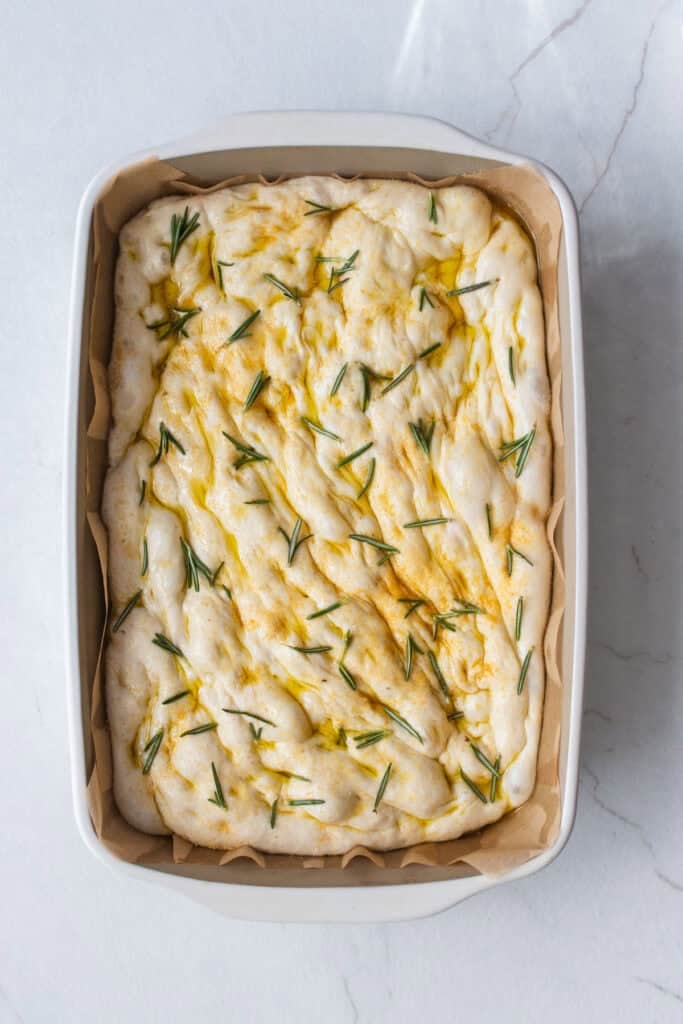
Step 9: Drizzle with a few tablespoons of olive oil and sprinkle with garlic powder and chopped rosemary.
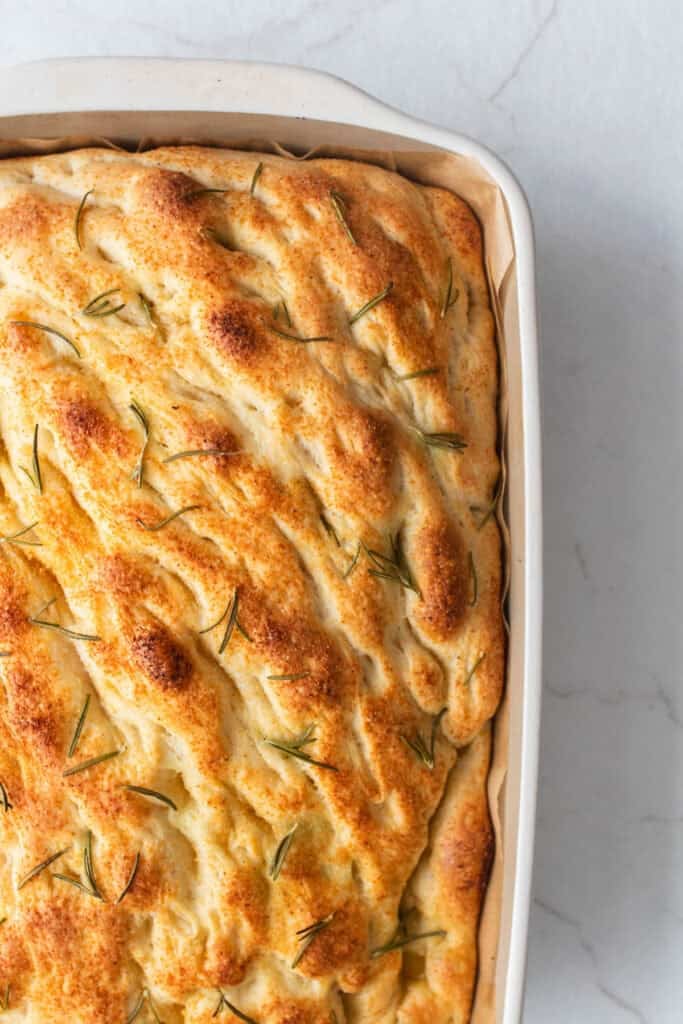
Step 10: Bake at 425 degrees for 20 to 25 minutes or until it is golden brown.
Tips
- Make sure not to over-ferment the dough. You will know if your dough is over fermented if it becomes a wet sloppy mess. It will be unworkable, and you won’t be able to shape it. If the dough over ferments, you can still bake it, and then turn it into sourdough breadcrumbs or sourdough croutons.
- The amount of flour you’ll need will depend on the moisture level of your starter. If your starter is pretty runny, you may need more flour for the best results.
- This is a wet dough and can be quite sticky, so it may be helpful to dab your fingers in oil or use wet hands to spread the dough into the baking pan.
- If you do not have a stand mixer you can also use the stretch and fold method. While the dough is in the bowl, grab the edge of the dough and pull up gently shaking the dough a bit while stretching it upwards. Then place the dough back in into the center of the dough. Turn the bowl a quarter turn and do this stretch and fold again, and again one to two more times. First 3 rounds of stretch and folds – every 15 minutes. Last 3 rounds of stretch and folds – every 30 minutes. Then cover and bulk rise
Recipe FAQs
Not traditionally. Most focaccias are made with commercial yeast. This is a sourdough version made with the wild yeast of a sourdough starter.
You can use bread flour or all-purpose flour for this recipe. I usually use all-purpose since it is easier to find and more versatile.
I say the secret is good quality ingredients, especially your olive oil. Also, fresh herbs like rosemary really help to elevate the flavor.
Store in an air-tight container at room temperature for best results. Can also be frozen up to six months.
Baker’s Timeline
12 PM: Feed sourdough starter.
6 PM: Create dough and allow to rise overnight.
6-8 AM the next day: Check the dough, if doubled in size place the dough in a parchment lined baking dish drizzled with olive oil. You can also stick it in the fridge to bake later. Press fingers down in the dough. Drizzle with more olive oil, salt, and herbs. Cover and allow to rise for a few hours.
10 AM: Bake or place in the fridge and bake right before dinner.
More Sourdough Recipes from the Farmhouse
- Easy Sourdough Dinner Rolls
- Sourdough Blueberry Cobbler
- Whole Wheat Sourdough Bread
- Sourdough Oatmeal Bread
- The Best Cranberry Banana Bread Recipe (Sourdough)
If you try this recipe and love it, I would love it if you could come back and give it 5 stars! Tag me on Instagram @farmhouseonboone.
Sourdough Focaccia
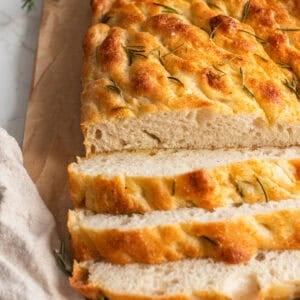
Ingredients
- 1 cup active sourdough starter
- 1 1/2 cups warm water
- 1/2 cup extra virgin olive oil, divided (plus one tablespoon for drizzling)
- 1 tablespoon honey
- 2 teaspoons sea salt
- 4 cups all-purpose flour
- 1 teaspoon garlic powder
- 2 sprigs fresh rosemary, chopped
Instructions
- Combine the sourdough starter, water, 1/4 cup olive oil, honey, and salt in the bowl of a stand mixer with a dough hook.
- Add the flour a half cup at a time until it starts pulling away from the sides of the bowl.
- With your mixer on low to medium speed, knead until smooth and elastic. This could take anywhere from 10 to 40 minutes.
- It should pass the windowpane test. Grab a small piece of dough and stretch it into a square. If it can stretch thin enough to see through without breaking, the dough is ready.
- Place dough in a greased bowl and cover with plastic wrap or a tea towel. Let it ferment at room temperature until it is bubbly/puffy and has increased by about half the volume. The time this takes can vary on many factors, especially temperature and time of year. This could take 4 hours if left in a warm place. I sometimes let it go 8 to 12 hours. Be careful not to over ferment the dough.*
- Put 1/4 cup olive oil in the bottom of a 9 by 13 baking dish lined with parchment paper.
- Press dough out in the baking dish, pressing fingers down in the dough carefully. Be careful not to deflate it, and press it all the way to the edges.
- Cover the dough in the baking dish with a tea towel or plastic wrap and allow it to rise for 1 to 2 hours at room temperature. It won’t double in size, but should become puffy and fill out the pan.
- Drizzle with a few tablespoons of olive oil and sprinkle with garlic powder and chopped rosemary.
- Bake at 425 degrees for 20 to 25 minutes or until it is golden brown.
Notes
- Make sure not to over-ferment the dough. You will know if your dough is over fermented if it becomes a wet sloppy mess. It will be unworkable, and you won’t be able to shape it. If the dough over ferments, you can still bake it, and then turn it into sourdough breadcrumbs or sourdough croutons.
- The amount of flour you’ll need will depend on the moisture level of your starter. If your starter is pretty runny, you may need more flour for the best results.
- The dough can be quite sticky, so it may be helpful to dab your fingers in oil or use wet hands to spread the dough into the baking pan.
- If you do not have a stand mixer you can also use the stretch and fold method. While the dough is in the bowl, grab the edge of the dough and pull up gently shaking the dough a bit while stretching it upwards. Then place the dough back in into the center of the dough. Turn the bowl a quarter turn and do this stretch and fold again, and again one to two more times. First 3 rounds of stretch and folds – every 15 minutes. Last 3 rounds of stretch and folds – every 30 minutes. Then cover and bulk rise.
Nutrition
Nutrition information is automatically calculated, so should only be used as an approximation.
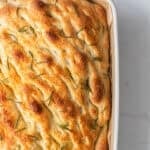
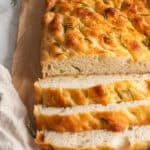
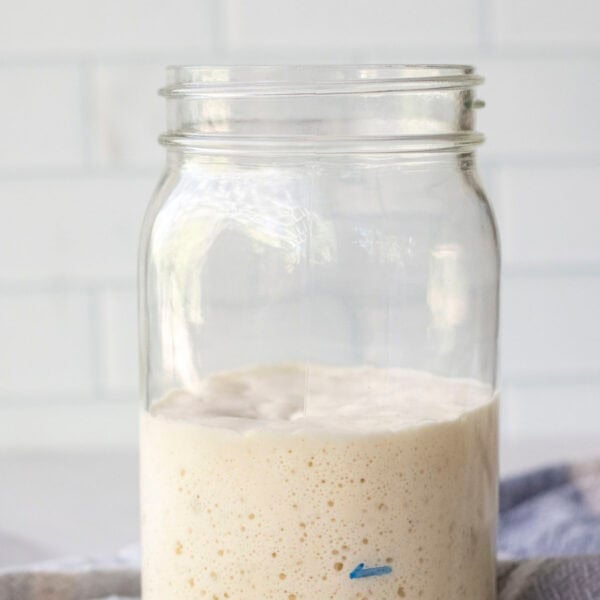
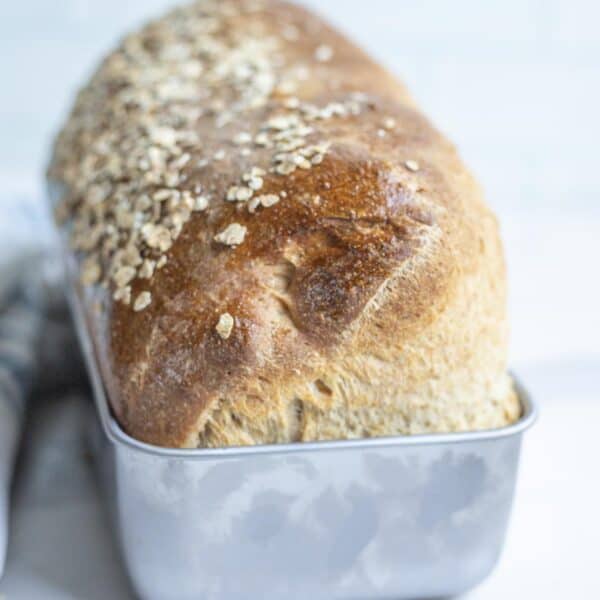
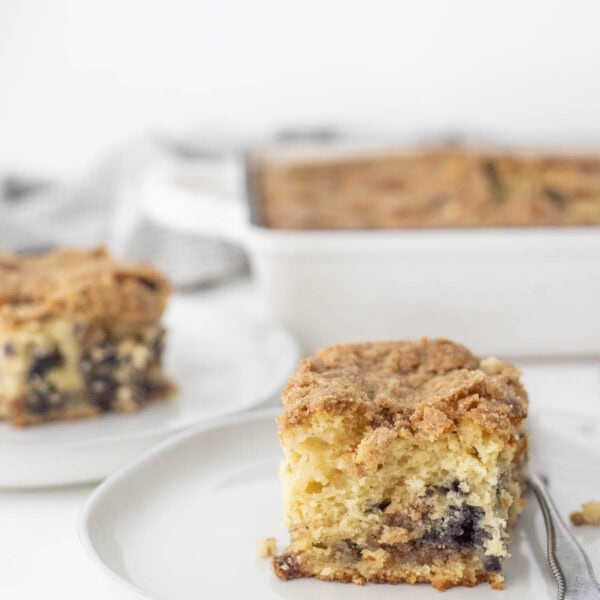
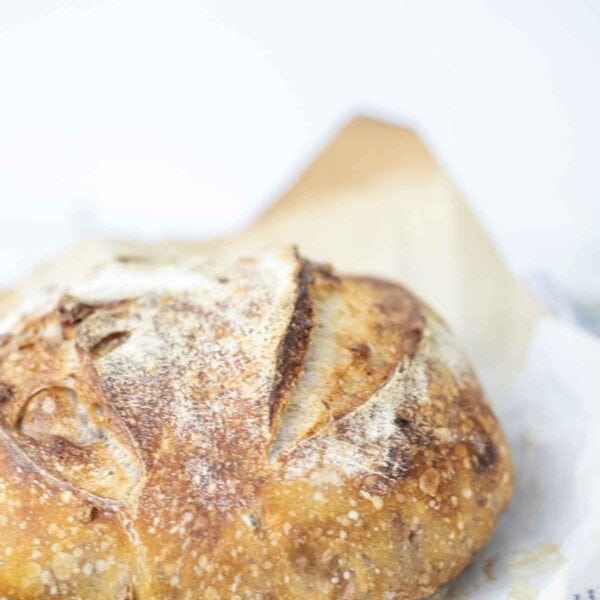






Do I let the dough sit out on the counter or in the fridge overnight?
What size pan? 9×13?
Should this dough stay a bit sticky after kneading? This dough just didn’t seem to form a ball like I would have expected it to.
Yea I would say it’s a little sticky. It doesn’t really form a ball like a normal bread dough.
Hi Lisa, on the tips for helping with gluten digestion, at what step in the process would you let it ferment for 24 hours? While the dough is rising? Thank you!
After mixing all of your ingredients together to form the focaccia, you can let it ferment for 24 hours!
Hi,
This would be my first time attempting to bake with sourdough and following your recipe. I just need clarification about temperature of oven settings: are you using Fahrenheit or Celsius? It just says “bake 400 for 20 min”
Fahrenheit! Sorry for that.
Is the focaccia ok to freeze?
Yes. You can freeze for up to 6 months.
When it is rising for a few hours on baking sheet do you cover or leave it uncovered?
You will want to cover it to avoid it forming a crust.
What Size pan do you recommend? Will a half sheet pan work?
A 9×13 works well
I’m wondering what size of sheet pan you recommend for the 20 minuets of baking. Also, the picture shows tomatoes on the bread, but there is no mention of it in the recipe. Just something to note
16” by 22”
What size baking sheet? I’m new to this and have never made focaccia! Also, ferment on counter top or fridge?
Ferment on the counter. You can use a standard size baking sheet. It all depends on how thick you would like it to be.